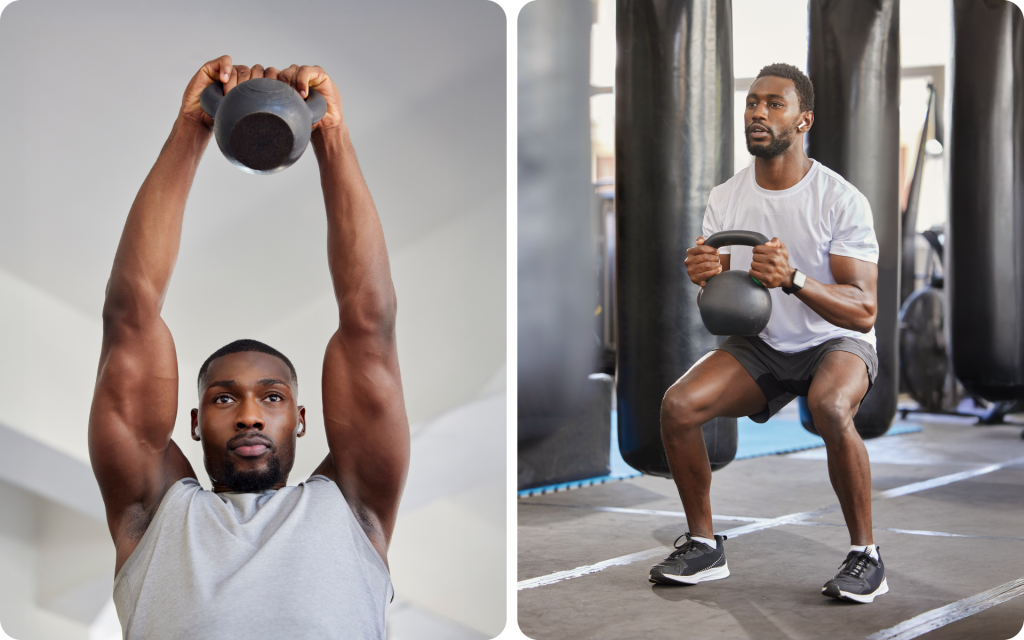Ask most obese people out there and most of them would give anything in the world to trade their bodies with a skinny one. Now, ask the same question to skinny people, and you’ll probably find many who’d go the extra mile to get a bit muscular.
If you’re in that second group, this article is for you. We’ve compiled some essential information and a powerful skinny to muscular workout plan to help you finally make those gains. Let’s see how!
What Is a Skinny to Muscular Workout Plan?
Strength training has been around for decades and it’s the best way to increase your muscle size. With the proper plan, you can put on muscle regardless of your size. A 2014 study even found that a 12-week strength training program could increase muscle size by approximately 4% (1). This goes to show that with consistent effort, you can change your body.
Nowadays, fitness pros swear by a full-on approach that mixes bodybuilding, strength training, and even a bit of cardio to help you go from skinny to strong and stay that way.
Can a Skinny Person Grow Muscles?
Yes, skinny people can build muscle. You need the right game plan and a workout routine for skinny guys that progressively builds up your strength.
Below are a few tactics that might help:
- Master The Basics: Perfect your form on fundamental exercises such as squats, deadlifts, pull-ups, and bench presses. These compound exercises can hit multiple muscles and trigger the hormones that drive growth (2). Mastering these movements will allow you to progress to more challenging variations and allow you to grow more muscle.
- Eat to grow: To gain muscle, you should eat more calories than you burn. This gives your body the fuel it needs to build new muscle. The best way to bulk is by focusing on whole, nutrient-dense foods, such as fruits, vegetables, meats, fish, nuts, and legumes. A balanced diet like this can help you hit your calorie goals while giving your body the necessary vitamins and nutrients to build muscle (3).
- Rest and recover: Muscles don’t necessarily grow in the gym – they’re actually broken down through strength training. Instead, they grow when you’re resting. Get plenty of sleep and give your body time to rebuild between workouts. Health authorities worldwide suggest giving each muscle group 48 to 72 hours of rest between resistance training sessions (4).
Even a small, consistent effort can lead to visible results. Your muscles are ready to grow – you just have to give them the right plan.
BetterMe: Health Coaching app helps you achieve your body goals with ease and efficiency by helping to choose proper meal plans and effective workouts. Start using our app and you will see good results in a short time.
How Do I Go from Skinny to Muscular?
Building muscle from a skinny frame takes a well-rounded approach that balances training, nutrition, and recovery. It’s less about what you do and more about how you do it.
The table below illustrates what you should do and how:
| Component | Goal | Action |
|---|---|---|
| Training | Progressive overload | Systematically increase weight, reps, or difficulty of your lifts every week to continually challenge your muscles. |
| Nutrition | Caloric surplus | Consume 300 to 500 more calories than you burn daily. This excess energy is mandatory for muscle building (5). |
| Protein intake | Fuel muscle repair | Aim for approximately 0.8 to 1.0 grams of protein per pound of body weight (or 1.6-2.2 g per kg) (6). |
| Frequency | Consistency and recovery | Train each major muscle group 2-3 times per week, allowing 48 to 72 hours of rest between sessions for the same muscle. |
| Sleep | Optimize recovery | Get 7 to 9 hours of quality sleep per night. This is when the body releases the most growth hormone and repairs muscle tissue (7). |
This is a roundup of what a person should do to build muscular strength. You should carve out a custom plan with the help of a certified trainer to ensure you are properly practicing the principles of progressive overload. Progressive overload is what allows the body to build more muscle over time. You may decide that you’re looking for a workout plan for skinny guys to build muscle fast and one of the most important aspects of this plan is that you’re consistently challenging your muscles each time you work out.
Read more: 5 Exercises for Seniors: Build Strength, Balance, and Mobility
Can a Skinny Guy Bulk Up In 3 Months?
Yes, a skinny guy can bulk up in 3 months. However, you need discipline and the right plan to make it happen. However, every plan brings a different outcome for each person, depending on their age, gender, genetics, and metabolism.
Complete transformation takes time. The first 12 weeks can produce visible results thanks to what’s known as “newbie gains”. This is when your body, which is new to resistance training, quickly adapts, building muscle and strength faster (8).
According to the American College of Sports Medicine (ACSM), beginners can gain approximately 1 to 2 pounds of lean muscle per month with consistent resistance training and proper nutrition (9). This means that adding 3 to 6 pounds of muscle in three months could be a realistic and healthy goal.
The foundation of bulking lies in progressive overload. This means gradually increasing your workout weight, reps, or intensity to challenge your muscles. You should focus on compound exercises such as squats, deadlifts, and bench presses. These recruit multiple muscle groups and trigger higher anabolic hormone release, which encourages faster growth (10).
Nutrition is equally important. To build muscle, you must eat at a caloric surplus. This refers to consuming more calories than your body burns. Research from the Journal of the International Society of Sports Nutrition (JISSN) recommended a protein intake of 1.6 to 2.2 grams per kilogram of body weight daily to support muscle repair and growth (11). Pair protein with complex carbs and healthy fats to sustain energy and recovery.
Getting your training volume and frequency right is essential for maximizing growth in 3 months. A few hypertrophy training principles that can help with muscle building during workouts for skinny guys include:
- Push your muscles to their limit: Muscles grow when you challenge them. Try to get within 1 to 2 reps of failure. The only way to know your limits is sometimes to reach failure. So don’t be afraid to push hard, particularly when doing isolation exercises.
- Train each muscle 3 times a week: After a tough session, muscles grow for 2 to 3 days. Training every second or third day keeps that growth going. The simplest way is to do 3 full-body workouts per week.
- Always try to beat your last workout: Intend to lift heavier, do more reps, or use better form every time. This steady improvement, known as progressive overload, can drive muscle growth.
- Focus on big compound exercises: Moves such as goblet squats, push-ups, Romanian deadlifts, and chin-ups work multiple muscle groups at once and build overall strength faster.
- Add isolation exercises to fill the gaps: Some muscles, such as your biceps, triceps, and shoulders, need extra attention. Add curls, triceps extensions, and lateral raises to strengthen these smaller muscle groups.
- Stick to 6 to 20 reps per set: You can go as low as 4 or as high as 40 occasionally, but the 6 to 20 range delivers the best balance for muscle growth.
A male 3-month body transformation isn’t an easy feat, nor is the female transformation. You may come across several challenges along the way, hitting plateaus, and feeling weak. At these turns, you should try to lift yourself up and not quit. Hear powerful stories of people who achieved transformation within months and equip yourself with the right strategies to keep going.
What Is a Solid Skinny to Muscular Workout Plan?
Below, we’ve provided a beginner-friendly 3-day-a-week, skinny-to-fit workout plan that can help you gain some muscle without straining yourself too much:
Day 1 – Full-Body Strength
- Squats (Bodyweight or Barbell): 3 sets of 8-10 reps
- Push-Ups or Bench Press: 3 sets of 8-10 reps
- Bent-Over Rows (Dumbbell or Barbell): 3 sets of 10 reps
- Plank Hold: 3 rounds of 30-45 seconds
- Biceps Curls: 2 sets of 12 reps
Day 2 – Upper-Body Focus
- Pull-Ups or Lat Pulldowns: 3 sets of 8-10 reps
- Overhead Shoulder Press: 3 sets of 10 reps
- Incline Dumbbell Press: 3 sets of 10-12 reps
- Triceps Dips or Triceps Pushdowns: 3 sets of 12 reps
- Lateral Raises: 2 sets of 15 reps
Whether you’re a workout beast or just a beginner making your first foray into the world of fitness and dieting – BetterMe has a lot to offer to both newbies and experts! Install the app and experience the versatility first-hand!
Day 3 – Lower Body and Core
- Deadlifts (Start Light): 3 sets of 6-8 reps
- Lunges (Per Leg): 3 sets of 10 reps
- Leg Press or Step-Ups: 3 sets of 12 reps
- Calf Raises: 3 sets of 15 reps
- Hanging Leg Raises or Crunches: 3 sets of 15 reps
This is a sample 3-day routine that could help you enhance muscle growth. When you focus on other lifestyle factors while following a routine like this, you may see better results.
What’s the Best Diet for Skinny to Muscular Transformation?
The best diet for a “skinny to muscular” transformation, often called a “bulking” diet, focuses on consuming a caloric surplus with a high intake of protein and complex carbohydrates.
The following are some principles and steps that could help:
Establish a Caloric Surplus
The most important factor for gaining muscle mass is consuming more calories than you burn (your total daily energy expenditure or TDEE) (12). When you know this number, add 250 to 500 extra calories daily to help your body build lean muscle without adding too much fat. If you naturally have a fast metabolism or struggle to gain weight, you may need to bump that up to 500 to 1,000 extra calories daily.
Keep an eye on your progress by tracking your weight regularly. You’re on the right track if you gain about half to one pound (0.25 to 0.5 kg) weekly. However, if your weight isn’t increasing, add another 200 to 300 calories daily until you start to see steady progress.
Prioritize Macronutrients (Macros)
To gain healthy muscle, pay attention to what you eat, not just how much you eat:
- Protein: Helps your muscles grow and recover (6). Include a good portion of protein in every meal.
Examples: Chicken, fish, eggs, milk, yogurt, lentils, beans, and tofu.
- Carbohydrates: Can provide you with energy for workouts and help you recover after (13).
Examples: Oats, rice, potatoes, pasta, whole-grain bread, fruits, and vegetables.
- Healthy Fats: These may support your body’s overall health and make reaching your calorie goals easier (14).
Examples: Avocados, nuts, seeds, olive oil, and nut butters.
Eating Strategies for Hardgainers
If you find it difficult to eat enough (a common struggle for skinny guys), try these simple tips:
- Eat more often: Eat 5 to 6 smaller meals or snacks instead of just 3 big ones. This is easier on your stomach and helps you get more calories in.
- Drink your calories: Make smoothies or shakes. They’re quick, filling, and easy to load with nutrients.
- Choose calorie-rich foods: Go for foods that pack a lot of calories in small portions, such as nuts, seeds, nut butters, dried fruit, oats and granola, olive oil (add a spoon to salads or rice), and full-fat dairy (if it suits you).
Read more: Full-Body Gym Workout for Men: A Beginner’s Guide
How Long Does It Realistically Take to Go from Skinny to Muscular?
It usually takes 6 months to 1 year to see noticeable muscle growth starting from a skinny frame. The exact timeline depends on your consistency, nutrition, genetics, and workout routine.
Here’s a general idea:
- First 1 to 3 months: You may build strength and improve form. Visible muscle changes can be small but noticeable.
- 3 to 6 months: Muscles start filling out, and your body looks more defined.
- 6 to 12 months: Consistent workouts and proper eating can lead to clear muscle gains and a stronger build.
Muscle growth is often gradual. You won’t see results within one month of doing workouts. It depends on many variable factors, and everyone has a different timeline.
How Much Sleep Is Needed to Gain Muscle?
Sleep isn’t just rest – it’s also the time when your body performs the most crucial aspects of muscle repair and growth:
- Hormone Release: The largest pulse of human growth hormone (HGH), which is essential for muscle tissue repair and growth, occurs during deep sleep (15).
- Protein Synthesis: Sleep can promote muscle protein synthesis (the process of building new muscle tissue) and helps balance hormones to prevent muscle breakdown (16).
- Energy Replenishment: Sleep helps replenish glycogen stores in your muscles, which are the primary fuel source for your next workout.
A 2021 PubMed study found that one night of sleep deprivation reduced muscle protein synthesis by 18%, raised cortisol by 21%, and lowered testosterone by 24%. This shows that quality sleep can be essential for muscle recovery and growth (17).
Difficulty is incredibly relative to each person. It can be challenging to lose a substantial amount of weight in the same way it’s challenging to gain a substantial amount of muscle. Both take consistent effort with proper food intake and exercise strategies. Skinny individuals usually have a fast metabolism and must consistently consume a significant calorie surplus to gain weight and muscle mass, which makes the dietary component a major challenge, while overweight individuals will need to reduce their calorie intake, which will likely decrease their daily energy levels. Both wellness journeys have different obstacles to overcome. Progressive overload (lifting heavier or doing more reps over time), consuming enough protein (1.4-2.0g per kg of body weight), and getting 7-9 hours of quality sleep can help muscle growth and recovery. Both are important. Eating a meal with protein and carbohydrates 1-2 hours before a workout can provide energy for performance. At the same time, a similar meal after a workout is essential for muscle repair and replenishing depleted energy (glycogen) stores. The calves and forearms are frequently cited as the slowest. This is because they are high-endurance muscles that are used constantly in daily life and may require high-frequency, high-volume, and varied training to see noticeable growth.Frequently Asked Questions
Is going from skinny to muscular hard?
What makes muscles grow faster?
Should skinny guys eat before or after workouts?
What is the slowest muscle to grow?
The Bottom Line
Building muscle as a naturally skinny guy isn’t easy, but it’s completely doable. Focus on a solid diet, consistent training, and rest – there’s no need to live at the gym. Stick to progressive overload and challenge yourself with each workout, and you’ll see results sooner than you know it.
A good skinny-to-muscular workout plan keeps things simple and helps you turn hard work into real gains over time.
DISCLAIMER:
This article is intended for general informational purposes only and does not serve to address individual circumstances. It is not a substitute for professional advice or help and should not be relied on for making any kind of decision-making. Any action taken as a direct or indirect result of the information in this article is entirely at your own risk and is your sole responsibility.
BetterMe, its content staff, and its medical advisors accept no responsibility for inaccuracies, errors, misstatements, inconsistencies, or omissions and specifically disclaim any liability, loss or risk, personal, professional or otherwise, which may be incurred as a consequence, directly or indirectly, of the use and/or application of any content.
You should always seek the advice of your physician or other qualified health provider with any questions you may have regarding a medical condition or your specific situation. Never disregard professional medical advice or delay seeking it because of BetterMe content. If you suspect or think you may have a medical emergency, call your doctor.
SOURCES:
- Neuromuscular adaptations following 12-week maximal voluntary co-contraction training (2014, pubmed.ncbi.nlm.nih.gov)
- The exercise-induced growth hormone response in athletes (2003, pubmed.ncbi.nlm.nih.gov)
- Advances in muscle health and nutrition: A toolkit for healthcare professionals (2022, sciencedirect.com)
- Effects of Consecutive Versus Non-consecutive Days of Resistance Training on Strength, Body Composition, and Red Blood Cells (2018, frontiersin.org)
- Nutrition Recommendations for Bodybuilders in the Off-Season: A Narrative Review (2019, mdpi.com)
- Dietary protein intake and human health (2016, pubs.rsc.org)
- Complex relationship between growth hormone and sleep in children: insights, discrepancies, and implications (2024, frontiersin.org)
- The influence of resistance exercise training prescription variables on skeletal muscle mass, strength, and physical function in healthy adults: An umbrella review (2024, sciencedirect.com)
- American College of Sports Medicine position stand. Progression models in resistance training for healthy adults (2009, pubmed.ncbi.nlm.nih.gov)
- How Does Physical Activity Modulate Hormone Responses? (2024, pmc.ncbi.nlm.nih.gov)
- How much protein can the body use in a single meal for muscle-building? Implications for daily protein distribution (2018, jissn.biomedcentral.com)
- Learn How Many Calories You Burn Every Day (n.d., tdeecalculator.net)
- High-Quality Carbohydrates and Physical Performance (2017, pmc.ncbi.nlm.nih.gov)
- Fats and Other Lipids (1989, ncbi.nlm.nih.gov)
- Growth hormone secretion during sleep (1968, pmc.ncbi.nlm.nih.gov)
- Sleep, circadian biology and skeletal muscle interactions: Implications for metabolic health (2022, sciencedirect.com)
- The effect of acute sleep deprivation on skeletal muscle protein synthesis and the hormonal environment (2021, pubmed.ncbi.nlm.nih.gov)














